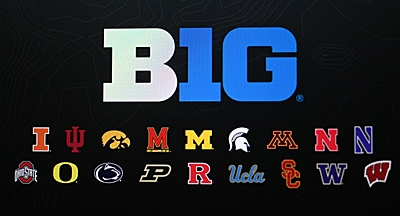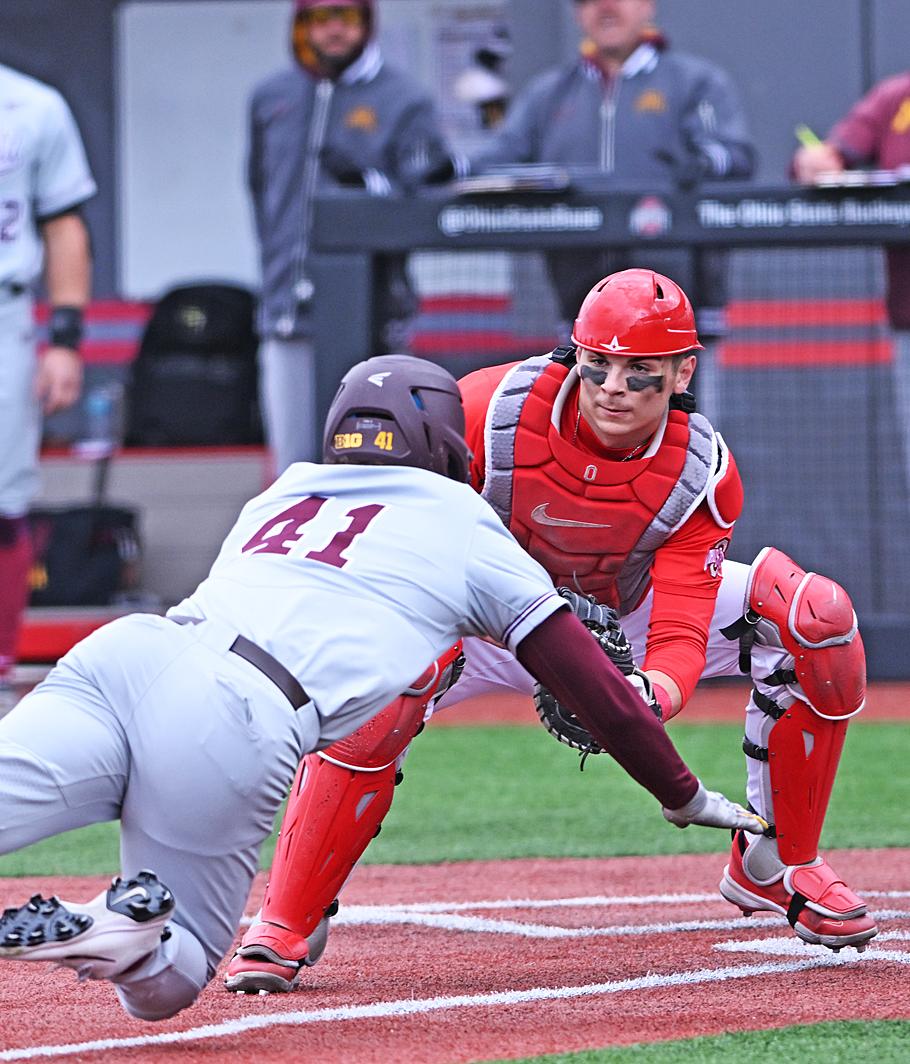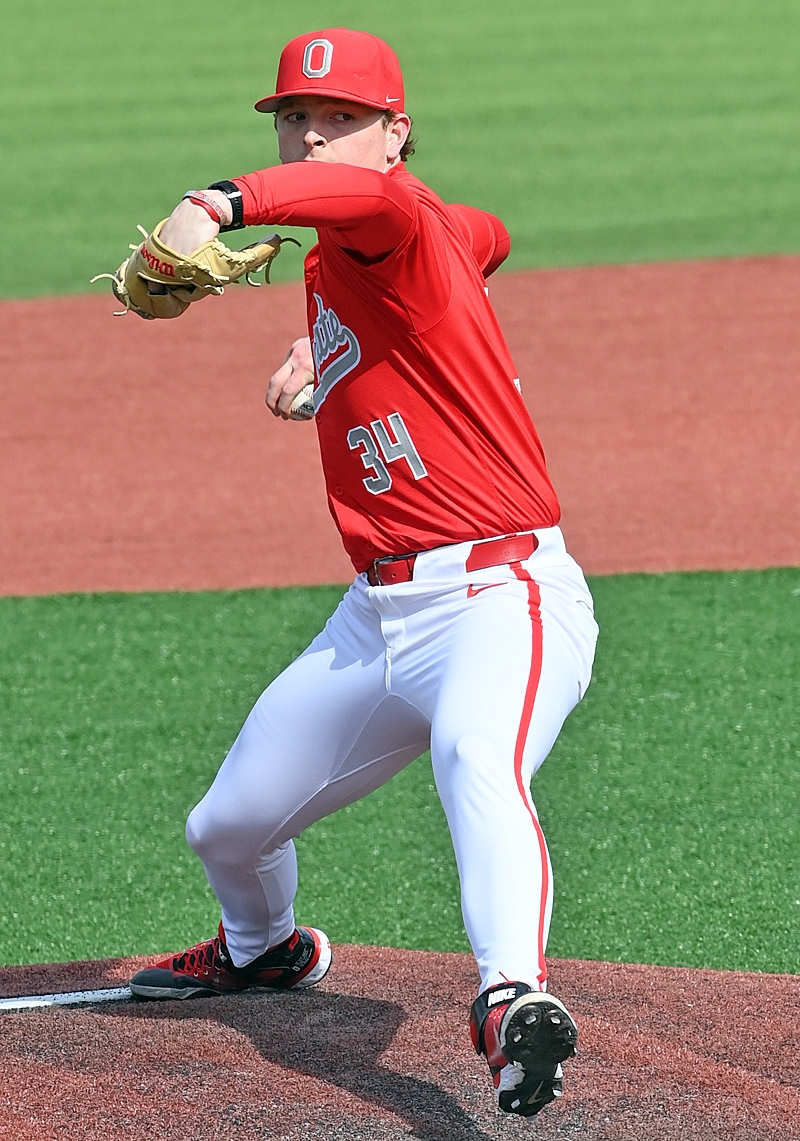
Into each life a little rain must fall…OSU coach Justin Haire withstood a deluge in his initial season with the Buckeyes. (Press Pros Feature Photos)
Two weeks after a shocking season for first-year coach Justin Haire, some thoughts on the next steps, the next roster, and the search for talent and culture.
 If you take the time to read the Old Testament and Psalms 121, there’s an oft-quoted verse from King David about a situation that Ohio State baseball Justin Haire must, himself, feel personally.
If you take the time to read the Old Testament and Psalms 121, there’s an oft-quoted verse from King David about a situation that Ohio State baseball Justin Haire must, himself, feel personally.
“I will lift my up mine eyes unto the hills, from whence cometh my help,” it opens, a reference to David’s ascent from the despair of being far from where he desired. Of course, different strokes for different folks, and you can pooh-pooh the corollary if you want. This is baseball, and King David never hung a slider or suffered through 352 walks by the pitching staff. Call it blasphemy, even. But in baseball terms, what’s more blasphemous than 8 walks per nine innings?

The Minster Bank is proud to sponsor the best in area sports coverage on Press Pros Magazine.
But King David did see some considerable things go wrong during the tenure of his reign, and in the end he showed instinct for exactly where he needed to go to find help.
And given that we devoted more time to Ohio State baseball than any other single baseball entity of baseball since February, it’s only natural that people write, or text, or question personally about 13 and 37, and why such a fall in such a short matter of time.
“It’s time for some truth,” writes 86-year-old Don Motz, a relative of 1946 coach Lowell Wrigley, who scrutinizes every box score and every statistic, and points out that there was not one Buckeye who made All-Big Ten, first, second, or third team.
Well the truth comes in many flavors, and after the fact the truth stands that if pitching is 80% of baseball the Buckeyes had the worst pitching staff in the Big Ten, with a cumulative earned run average of 9.62, the 352 walks compared to 387 strikeouts, 88 wild pitches and 94 hit batsmen.
And to further magnify that deficiency, consider that the team hit .265, a figure comparable with the last five years in which the Buckeyes finished with winning records. The only thing that was significantly different during 2025 was the pitching.
 That said, there must be concern over positions other than pitching for 2026, as veteran talents like Matt Graveline (the most athletic catcher in the Big Ten, hit .284), Tyler Pettorini (hit .319), Trey Lipsey (hit .300), and Nick Giamarusti all leave the program…with the possible exception of Graveline, who’s a junior and draft eligible. That said, a major league scout that I talked with during the final month shared this:
That said, there must be concern over positions other than pitching for 2026, as veteran talents like Matt Graveline (the most athletic catcher in the Big Ten, hit .284), Tyler Pettorini (hit .319), Trey Lipsey (hit .300), and Nick Giamarusti all leave the program…with the possible exception of Graveline, who’s a junior and draft eligible. That said, a major league scout that I talked with during the final month shared this:
“There’s more opportunity here than any other Division I program I can think of. If you want to play at this level, why wouldn’t you want to come to Ohio State?” Rest assured, that has to be Justin Haire’s best recruiting pitch.
It’s true that I did miss on my assertion in February that the league, itself, would be in an overall adjustment mode in 2025, selling teams like UCLA, USC, and Washington short. Michigan proved to be better than I expected. And Nebraska, who labored through the first half of the season, came on strongly at the end to actually grab the eighth seed in the tournament and win it, 5-0 over UCLA in the title game. All that proves is that big things can happen in a short matter of time when you look to the hills, because UCLA finished dead last in PAC 12 Conference standings in 2024, only to come back and finish tied for first with Oregon in the Big Ten – and win the tournament title – a year later.
So, what comes next?

Returning talent…junior-to-be catcher Mason Ecklelman showed dramatic improvement both behind the plate and at the plate (.281) in 2025.
Foremost, some patience regarding Justin Haire, who did not come to Columbus on a load of melons. He has a winning background at Campbell, had a winning record against Ohio State as the coach of the Camels, and impressed me specifically in this one regard during his initial season. He made sure that every one of the players he inherited got a chance to make a case for himself. He showed incredible patience, and out of necessity, having lost two of his three primary weekend starting pitchers early due to injury. And you cannot defend 12.15, 12.43, and 13.14 earned run averages of his three primary starters, all of which pitched 25 innings or more.
So you can expect an almost-complete turnover in that pitching staff for 2026 through incoming freshman recruits and the portal. But the portal is no magical fix, because they wouldn’t be in the portal if they were capable of pitching at the school they’re leaving. There are exceptions, but there weren’t many this year.
That said, there are some arms that pitched steadily – Hunter Shaw, Gavin Kuzniewski, Chase Herrell, Doug Bauer – but you can’t turn this thing around on four arms, and Blaine Wynk is presumed gone with the MLB draft, come July. So, yes, without more specific knowledge, there’s going to be a significant turnover. And there is already!

Logan Services, in Dayton, Cincinnati, and Columbus proudly sponsors your favorite sports on Press Pros Magazine.com.
With that comes the constant cry from Buckeye bluebloods to better recruit Ohio high school baseball. The OHSAA state tournament come around in a couple of weeks and eyes will be glued on the stands to see if they’re better represented than they were during the Mosiello years.
And how do so many prospects seem to get out of Ohio to go someplace else?
Well, there’s a mess of factors with that, starting now with the state of the Buckeyes program rebuild, the amount of available NIL money when compared to teams from the South, and questions about the culture of baseball, not only at Ohio State, but in the Big Ten, as well.
Like it or not, pitchers like Paul Skenes (Pirates) and Jack Lieter (Rangers) don’t often show up at Big Ten schools. Both were immediate impact players at LSU and Vanderbilt and they chose to play where baseball is more richly supported and it’s played in warm weather. Skenes transferred into LSU from the Air Force Academy without ever considering a Big Ten school. And when you ask veteran Big Ten coaches about the disparity they make no bones – that Snowbelt baseball is viewed differently.

The loss of weekend starter Chase Herrell helped put Buckeye pitching on an early downward spiral.
“My fear is that we’re viewed as a developmental conference where players come to learn, then leave at the sight of the highest bidder,” said one during this past season.
“Not until they do something about the season and the weather,” more than one will tell you.
And, “We’re not in position to compete with NIL money that other schools have,” said OSU athletic director Ross Bjork at the time of Justin Haire’s hiring.
So if you’re recruiting Ohio kids you have to really find talent that’s tied to a tradition of football and competitive respect in sports besides baseball. O-H is nice, don’t get me wrong. But this is a different day. It doesn’t $pend!
The other factor is where has high school talent, Ohio or otherwise, has learned to compete. A lot of Ohio high schoolers have impressive numbers, but numbers against who? We know now that it makes a difference.
We saw plenty of velocity this season from the existing staff, but the reality of amateur baseball is that it doesn’t prepare you to face kind of velocity killers you find in college baseball. You must be able to execute secondary pitches with confidence and efficiency and there’s nothing with Prep Baseball rankings that adequately quantifies that. Pitching at this level becomes a heart and mind matter, and a matter of touch. Not just how hard you can throw.

Publisher Sonny Fulks writes OHSAA sports and the Buckeyes for Press Pros Magazine.
And for that reason I’m increasingly questioning of the culture of ‘select’ and ‘travel’ baseball, both the quality of competition and the quality of instruction with what it’s sending to the next level of baseball. Obviously, not enough kids are prepared when they get here.
Obviously, Junior College is the better route for many to make the transition, and that’s a place where I think you can expect to see Ohio State in its search for pitchers who can throw strikes and throw strikes with more than one pitch…and yes, I’m assured that there are some hopeful incoming freshmen arms to develop.
Hence, you might expect that help is going to come from the hills in 2025, and I don’t mean Beverly Hills. Justin Haire, Ty Robinson, and Joe Holcomb need a certain type of help, one that’s both patient with the process and the prospects of something beyond baseball. Playing college baseball is wonderful, but as Michigan coach Tracy Smith told me this spring, “You’re cheating yourself if you turn down a degree from a place like Michigan or Ohio State to play baseball at a school with more NIL money.”
And I can’t disagree as a member of that 1972 team that went 11 and 25. My time at Ohio State, nevertheless, served me well.
You’re familiar with the television ad that says, “Almost all of us will being going pro in something besides sports?”
That’s a fact…one as old as the hills.

